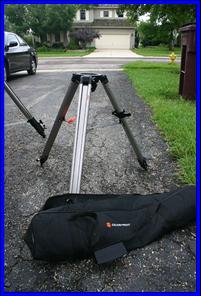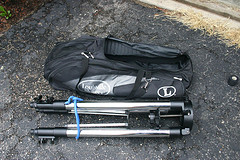Take Me Out to the Tripod Game
Joe Shuster
Last time I introduced the concept of a "virtual astronomy store". After all, we don't have genuine, dedicated store or section of a store with a lot of the materials and tools we need to complete astro-DIY projects. So the concept requires some imagination - we mentally synthesize the virtual store from parts of other stores. Those store sections probably have nothing to do with astronomy, however. It's our cleverness (and sharing) that turns these otherwise disconnected sections into parts of the virtual astronomy department.
In the first article, I discussed finding a method to find a hand controller rest for a Gemini hand controller or other handheld accessory for those times where you don't need to hold the controller. In this article, I want to discuss the options in finding a portable, large, inexpensive carrier for tripods (or bits of tripods for those that disassemble).

Tripods are notoriously awkward. They have locking knobs that stick out, pointy feet, and their top - where the telescope goes - can be big and/or expose damageable hardware (like an attachment bolt). And many telescope tripods disassemble to some degree. Some allow you to remove a leg stiffener, an accessory tray or a keypad holder. These and other parts like removable retaining bolts, cables, etc., need to be kept together or else you could find yourself missing critical pieces that ruin a trip to a dark site.
Another curious aspect of tripods is their fragility. These devices are the foundation for your optical equipment and the best ones are solid and heavy. Their legs are usually adjustable but still firm enough to eliminate shaking through the scope. The problem is that a ding or dent to your tripod legs can ruin the tripod. It might be difficult or impossible to extend or retract the legs for height adjustment and storage. Or worse, the leg could be weakened - something you might only detect when the fully loaded optical and mount system forces the leg to collapse. And beyond the critical danger of dings, most of us like to keep the tripod bruises to a minimum for aesthetic reasons or to maintain the resale value of the equipment.
So despite the rugged look of tripods, they need some protection from random damage to the legs, exposed mechanics and critical accessories. Our tripods deserve a case. Of course, some equipment vendors sell hard and soft cases with the corporate logo imprinted. But the cases are poorly marketed or distributed and the prices can be a bit excessive. Instead, I want to take you to the best spot in the "astronomy department" to find a case for your tripod.
Now any sufficiently big duffle bag will suffice as a tripod holder. But duffle bags provide no padding and few pockets. Plus the shape of a closed tripod is long and thin while duffle bags have a more squat length-to-circumference aspect. This means that the duffle bag that holds a tripod is usually ridiculously roomy. If you take your tripod to the "duffle bag" shelves of the "Tripod Case" section in your local Astronomy Department you'll see what I mean. Personally I find that duffle bags don't solve half the issues surrounding tripod transportation and storage. Instead, I've found some pleasant surprises in cases for baseball bats and hockey equipment.
To start, let me talk about smallish tripods. My NexStar 80 from Celestron came with a very small tripod with simple square aluminum adjustable legs. At Astrofest, I found a good price on a Celestron logo case for the tripod and I'll admit it fits nicely, has nice pocketing and some padding.
One day recently I was in my garage switching my softball gear - bats, gloves, spikes, balls - from an old case to a new, bigger one. The old bag was a little small and only held one bat but it was otherwise in good shape and I didn't want to discard it. Then I realized it might be perfect for the NexStar tripod. Sure enough, the small tripod fit nicely inside with room for the tray/stiffener, power cables, and hand controller. And bat bags have a hook at one end for hanging the bag on a fence, so the bag and all its enclosed equipment can easily be hung on a hook in the garage. So if you have a small tripod - even a camera tripod - you will find that just about any baseball bag will give your tripod and accessories some protection while offering you the shoulder straps and handles to make portability easy.
When you step up to medium size telescope tripods, it's a little trickier. Obviously, they're longer - about 36" fully folded - and some have large surfaces to attach the scope. The prime example is the tripod for my older NexStar 5. The round bottom of the NexStar base is a fairly large 8 inches, meaning the tripod top ("face plate") needs to be the same size. So problem number one with this size base is that the large faceplate needs to fit inside the bag. Many bags are designed for one bat, a glove, a couple of balls, and a pair of spikes. Those bags might be fine for the foot end of the tripod, but the large face wouldn't fit.
The second problem is the design of the bags. Most bags have a zippered opening into the interior storage that is only 65-75% of the full length of the bag's main storage and centered on the bag's length. (The bat or bats slide into a separate narrow pocket.) So even if a bag's specified length is sufficient for your tripod, the tripod might not fit through the narrowed opening.
When I took my the tripod for my NexStar 5 to the Astronomy Department at Gurnee Mills - yes I really did - I struggled with squeezing the tripod into bags that seemed plenty large enough based on the specification. Feet-first or face-first it just wouldn't get inside. Then I remembered something unique about baseball bags. They often provide an isolated section for the spikes. You can put wet or dusty spikes into this compartment and keep the residue from the gloves and balls in the main section. The spike pouch almost always has an outside access flap that zips open and closed.

So before I gave up on a baseball bag for my NexStar tripod, I decided to see if this pocket would help: I opened the spike pouch cover and slipped the tripod feet-first into the main compartment toward the spike pouch. The spike pocket happily extended out of the bottom of the bag perfectly to let me slip the face of the tripod into the main part of the bag. The face then slipped to the top of the bag. Then, spike pocket tucked inside so that I could zip up the pocket flap. It was really nice of those baseball bag designers to think of about how astronomers might want to fit a tripod inside their bags.
For a moment I considered whether or not I wanted to just cut out the whole spike pouch. If I did that I could extend the feet to about any length outside the open flap instead of the limited 15" or so that the pocket allows. And with a smaller face tripod, I could use the flap for a bottom load/remove port. But the NexStar tripod face is too big for the flap opening and I already had enough space for fitting the tripod, so I kept the pocket. If you have a tripod with a smaller face or you need more extension of the feet to fit inside you might have luck removing the spike pocket.
I didn't think my Meade Field Tripod would fit into the same bag that tightly fit my NexStar 5 tripod. The total length of the folded tripods is pretty close but the Meade has a bigger faceplate, fatter feet, larger locking knobs, and a 2" long attachment bolt. Setting the tripod and bag next to one another for a photo it looked hopeless. Surprisingly, the same spike pouch trick worked for the Meade tripod. The fit was just a little tighter overall. To protect the bag and the attachment bolt, I'll need to fashion a protector so the bolt doesn't wear through the bag and so the bolt's thread aren't damaged. (That's "foreshadowing"! Watch this space.)
I also want to try for a solution for my largest tripod - my Losmandy G-11 tripod. This one has removable legs and a very awkward central joint. I don't think any size baseball bag would even hold the bulky legs. So I'll be investigating the big brother to baseball bags: Hockey equipment bags. These monsters can carry a set of leg pads, oversized padded shorts, shoulder pads, helmet, gloves and skates. Many have wheels for better portability. I'll let you know how that works out.
Meanwhile, back to the small and medium tripod solution: baseball bags. I talked with a manager at the store to find out about times when you might find discounts on bags. In the very large stores those times will be pretty random - more based on the individual bag vendors' incentives to stores instead of seasonal demand. But in medium and small sports stores, the April-May and October-November times offer good opportunities at the beginning and end of the season when they want to eliminate off-season stock or they want you to buy before a season starts.
I picked up the smaller Celestron bag for under $25 (original list was $60) while the bigger bag -- a Louisville Slugger Omaha Equipment Bag -- was at the high end of what I wanted to spend: $50. It's a bit more of a bargain for someone like me that can use it for 2 or 3 tripods. With carefully discounting hunting you can probably get 30-40% off. The discounts on eBay are even greater, especially on used bags but you can't try bags to see if they fit. I'm not comfortable with the practice of using the samples at a brick-and-mortar store and then going on-line for the purchase. It feels like the consumer version of bait-and-switch.
One other issue is how the bags are displayed at the store. The bags I tried could come out of their packaging to let me see how the tripod fit. There were other bags that looked like they had some potential, but I would have had to break the seal on the container and I chose not too.
So if you want to protect your tripod and keep all the associated bits together in an easy to carry package, haul your tripod into the Astronomy Department and try on some baseball bags for size. I bet you won't strike out!
Next time, I'll talk about one of Jack Kramer's favorite parts of the Astronomy Department: The full name of the store is Astronomer's Craft Equipment but you probably just know it by its abbreviation.
Published in the September 2007 issue of the NightTimes




